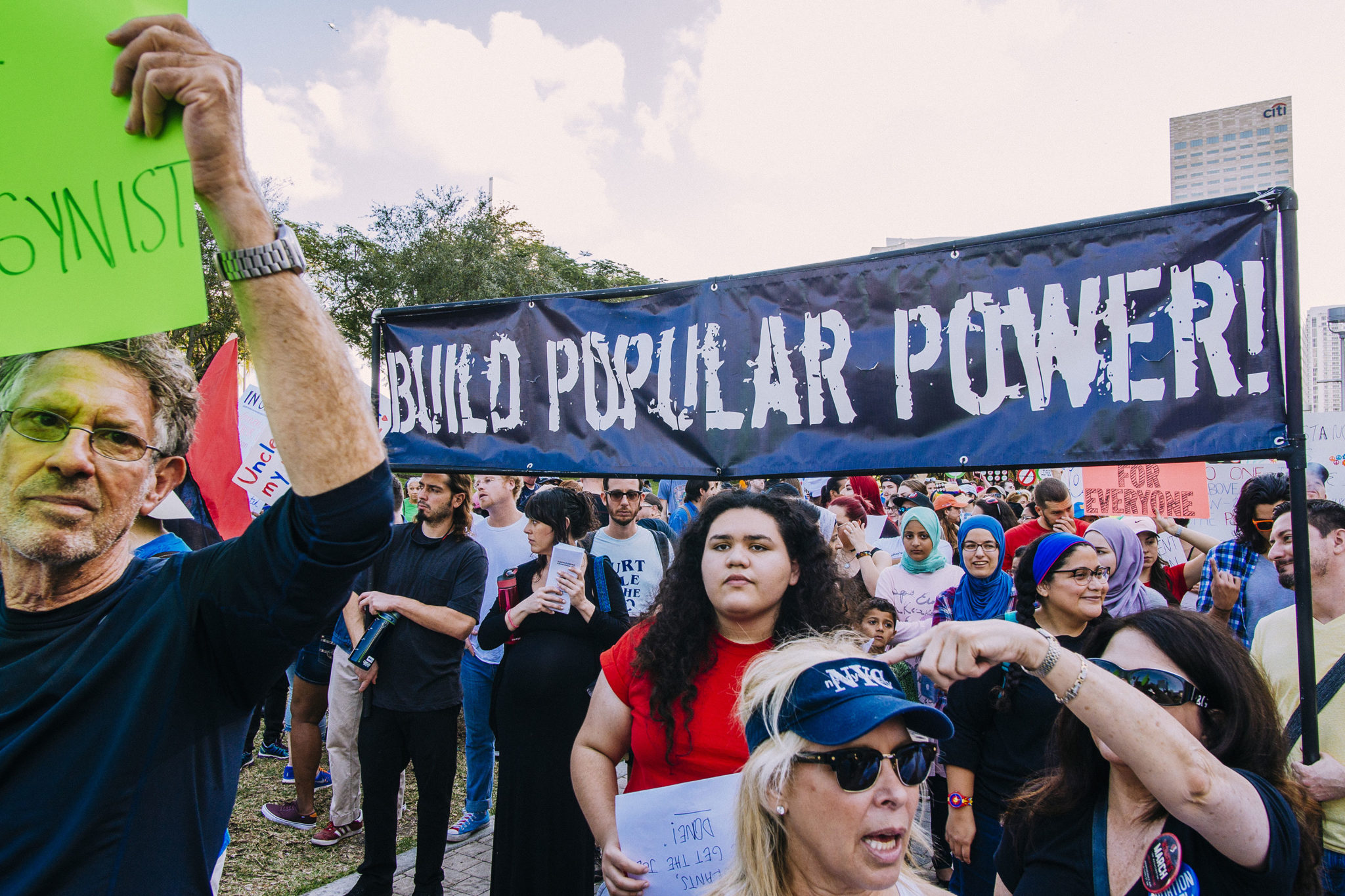
From South Florida Resistance
Download a pamphlet version of this article here.
In the early days of the Trump administration, we are seeing Trump’s utilization of executive orders to initiate and/or implement a wide array of right-wing policies. He is starting to make troubling organizational moves, such as the appointment of Steve Bannon- the former executive chairman for Breitbart News, a platform for the Alt-Right- to his National Security Council. We are seeing the emboldenment of the far right and the rising possibility of international warfare with nuclear capable countries such as China. Many are feeling overwhelmed and questioning the best way to resist. None of us has the power to resist these attacks individually; but we do have the power to resist collectively.
We have been engaged in protest actions across the nation mobilizing large numbers of people; but this is not enough. Now is the time to build and strengthen groups in our schools, communities and workplaces to not only resist the far right agenda, but to move on the offensive while building bottom-up popular power in the process. There are three ways we can do this and all of them are necessary: 1) maintain the protest mobilizations, 2) engage in efforts to criticize the right and put forward alternative ideas, and 3) build collective sites of popular power for resistance, as well as going on the offensive towards a more free and egalitarian society.
Three Pronged Approach
There have started to emerge mass protest actions resisting Trump’s far-right agenda building on momentum of ongoing action such as Black Lives Matter protests. These are useful for the morale of those who feel alienated and isolated, for an expression to the elites of our willingness to take to the streets to express our discontent, and to build connections with others in struggle. These are important actions and should continue with efforts at trying to expand our capacity for mobilization including strategic disruption efforts and connection to flyering, message building and dialogue with others who are part of, or witness to our mobilizations.
Part of our activity, has been and also must continue to be the development of critique of the right and putting forward our ideas. There’s a reason that Steve Bannon was associated with a publication such Breitbart; there’s a reason why Trump paid people to argue on social media. There’s a reason why politicians give speeches and create campaign literature. We need to engage with our ideas. People have the capacity to think for themselves; but we need to put forward our critiques and perspectives in the competition for the battle of ideas. This must be done as communication, not just expression; we must look to communicate with others, not at others.
There’s little sense attempting to communicate with the elite or far right militants; but by engaging working people like ourselves in communication about our ideas, we can win more adherents to our movement and grow our own ideas in the process of dialogue. This can include public workshops, one-on-one dialogues, writings, social media conversation, etc. This needs to continue, increase and take on a serious reflective quality that moves beyond sloganeering and expressions, towards engaged and thoughtful communication.
The third aspect that is fundamental is to build bottom-up, directly democratic, anti-oppressive, direct action oriented, popular power. Whether in our schools, communities or workplaces, we all should start to dialogue and develop relationships with like-minded individuals. We should be developing communication infrastructure (utilizing encrypted communication such as Signal when possible) to be able to quickly dialogue and mobilize our groups for resistance when necessary. These groups can also be utilized to build relations of solidarity with other groups as part of the broader resistance and movement for popular power. In addition, they need to be platforms to agitate, to put forward our critiques and argue for our alternatives. Students should look towards building student unions or student collectives; workers should get involved in their union where there’s democratic participatory practices or build a tendency within their workplace where a union doesn’t exist or the union doesn’t allow for participation; communities can build neighborhood associations or issue-based groupings around areas that affect them and others around them (from anti-deportation defense, to housing struggles, to anti-fascist organizing, to anti-police brutality action, to various other struggles).
Organizing Our Power
These groups and the connections between them are the basis for resistance and bottom-up popular power. They must be serious, accountable, connected and empowering to those involved. Decisions should be made collectively and democratically by all those involved. We should actively be confronting oppressive tendencies as a way to build our unity within these groups and be inclusive. These groups should be oriented towards action autonomous from the elites, and autonomous from intermediaries. We must act directly to force the hands of the elites where we have power. We also must act to defend targeted working class communities from immigration raids, far right hate attacks and other oppressive actions. This action might take the form of non-cooperation, strikes, boycotts, sabotage, obstruction, community defense and other forms of resisting strategically at the sites where power operates.
We can look to inspiration from a wide variety of collective, autonomous, direct action oriented groups, some of the most recent prominent US-based groups include elements within the Black Lives Matter movement and the Standing Rock Sioux’s Anti-DAPL struggle. However, there are hundreds of thousands of activists, organizers and engaged individuals involved in everyday struggles including tenants unions, solidarity networks, anti-deportation struggles, reproductive justice movements, unions and other forms of autonomous workplace organizing, indigenous autonomy movements, antifascist/antiracist organizing efforts, environmental justice struggles, queer liberation actions, international solidarity efforts, feminist movement building, and so many more. The power of the elites depends on all of us; we don’t depend on the elites for power. However, we must organize ourselves and identify how we can undermine their efforts by building our solidarity, organization, consciousness and capacity to resist and act collectively.
Taking Ourselves Seriously
If we are to effectively resist, we must take this moment seriously and resist where we are and how we can. In this process we need to continue with our mobilizations while strengthening our bottom-up collective power and promoting our alternatives. The elites and those within institutions of power will not save us; though they will look for ways to opportunistically advance- but their power comes from our compliance. The resistance must be developed a new and taken to the next level. Along the way it must be based in building solidarity in defense of specifically targeted communities. Now is not the time to be overwhelmed by helplessness and isolation, now is the time to mobilize, educate and organize together to build the resistance and move our society towards the free and egalitarian society which we all deserve.
